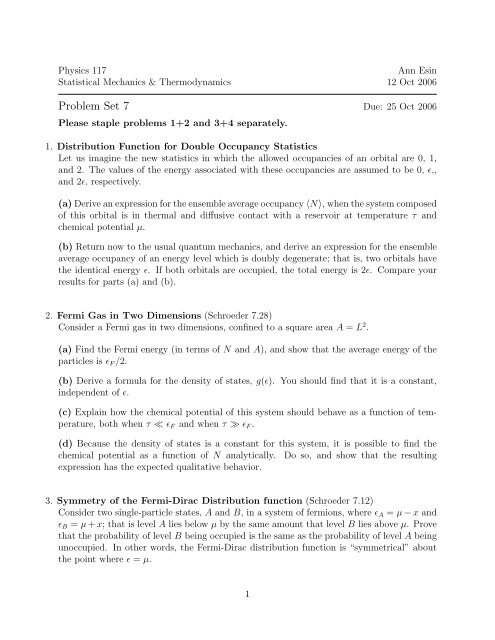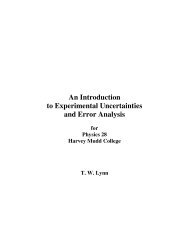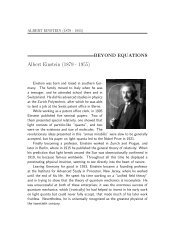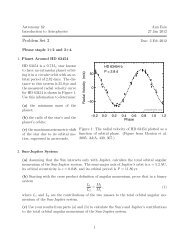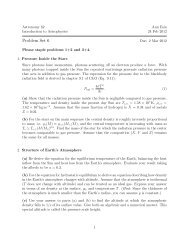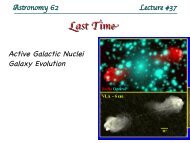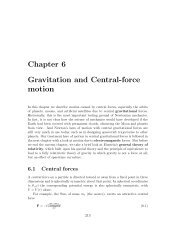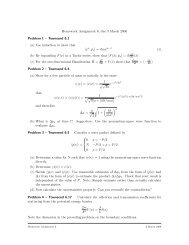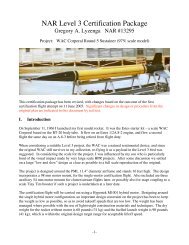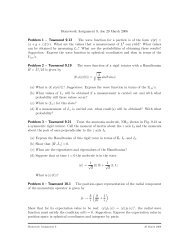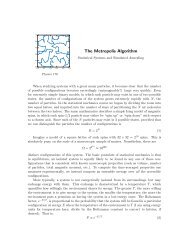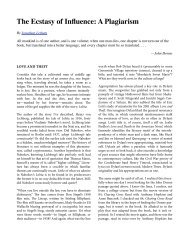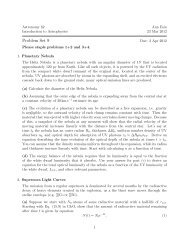Problem Set 7 - HMC Physics
Problem Set 7 - HMC Physics
Problem Set 7 - HMC Physics
Create successful ePaper yourself
Turn your PDF publications into a flip-book with our unique Google optimized e-Paper software.
<strong>Physics</strong> 117Ann EsinStatistical Mechanics & Thermodynamics 12 Oct 2006<strong>Problem</strong> <strong>Set</strong> 7 Due: 25 Oct 2006Please staple problems 1+2 and 3+4 separately.1. Distribution Function for Double Occupancy StatisticsLet us imagine the new statistics in which the allowed occupancies of an orbital are 0, 1,and 2. The values of the energy associated with these occupancies are assumed to be 0, ɛ,,and 2ɛ, respectively.(a) Derive an expression for the ensemble average occupancy 〈N〉, when the system composedof this orbital is in thermal and diffusive contact with a reservoir at temperature τ andchemical potential µ.(b) Return now to the usual quantum mechanics, and derive an expression for the ensembleaverage occupancy of an energy level which is doubly degenerate; that is, two orbitals havethe identical energy ɛ. If both orbitals are occupied, the total energy is 2ɛ. Compare yourresults for parts (a) and (b).2. Fermi Gas in Two Dimensions (Schroeder 7.28)Consider a Fermi gas in two dimensions, confined to a square area A = L 2 .(a) Find the Fermi energy (in terms of N and A), and show that the average energy of theparticles is ɛ F /2.(b) Derive a formula for the density of states, g(ɛ). You should find that it is a constant,independent of ɛ.(c) Explain how the chemical potential of this system should behave as a function of temperature,both when τ ≪ ɛ F and when τ ≫ ɛ F .(d) Because the density of states is a constant for this system, it is possible to find thechemical potential as a function of N analytically. Do so, and show that the resultingexpression has the expected qualitative behavior.3. Symmetry of the Fermi-Dirac Distribution function (Schroeder 7.12)Consider two single-particle states, A and B, in a system of fermions, where ɛ A = µ − x andɛ B = µ + x; that is level A lies below µ by the same amount that level B lies above µ. Provethat the probability of level B being occupied is the same as the probability of level A beingunoccupied. In other words, the Fermi-Dirac distribution function is “symmetrical” aboutthe point where ɛ = µ.1
4. Paramagnetic Fermi Gas (based on Schroeder 7.36)Most spin-1/2 fermions, including electrons and 3 He atoms, have non-zero magnetic moments.A gas of such particles is therefore paramagnetic. Consider, for example, a gas offree electrons, confined inside a three-dimensional box. The z component of the magneticmoment of each electron is ±µ B . In the presence of magnetic field B pointing in the zdirection, each “up” state acquires an additional energy of −µ B B = −δ, while each “down”state acquires an additional energy of +µ B B = δ. (Do not confuse µ B , magnetic moment,with the chemical potential µ!)(a) Without doing any calculations, explain why you would expect the magnetization ofa degenerate electron gas to be substantially lower than that of an ordinary paramagnet(discussed in Chapters 3.3 and 6.2 of Schroeder), for the same number of particles and fieldstrength. Recall, that the magnetization is given by µ B (N ↑ − N ↓ ), where N ↑ and N ↓ are thenumbers of electrons with up and down magnetic moments, respectively.(b) Write down a formula for the density of states of this system in a presence of a magneticfield B, and interpret your formula graphically. (Hint: Think of the two spin orientationsas two different types of particles and write down the density of states for each type. Keepin mind that the two types of particles are in diffusive equilibrium and therefore much havethe same µ, i.e. ɛ F .)(c) Find a formula for the magnetization of this system at τ = 0, in terms of N, µ B , B,and the Fermi energy. Assume that δ ≪ ɛ F . Compare your result to Eq. 3.35 in Schroeder,which describes magnetization for an ordinary paramagnet in the high-temperature limit.2


